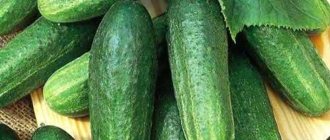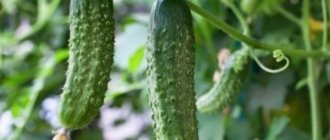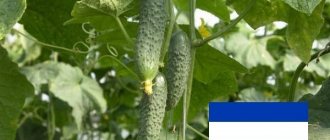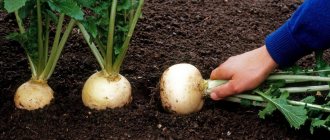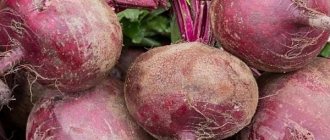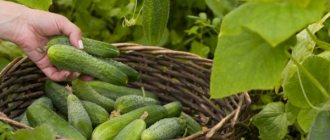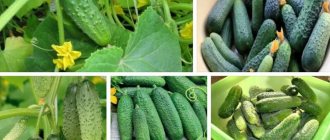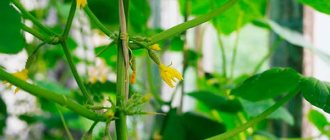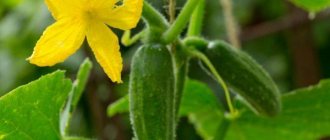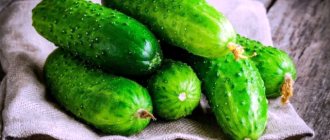Detailed description
The main difference between Chinese cucumbers is their long, spiny fruits, reaching a length of 80-90 cm. Other features of the crop:
- Bush. The plant has the appearance of a vine; each layer produces 3-4 fruits. The bushes are powerful, with thick stems and large leaves;
- Fruit. The diameter is no more than 7-8 cm, the average length is 50-80 cm, there are no voids inside the fruit. The skin color is dark green, the surface is pimply. The seeds are small, underdeveloped, soft, and do not become coarse as the fruit grows;
- Flowers. Mostly female, collected in bundles of several pieces. There are a lot of ovaries on the plant.
Experienced gardeners advise using the fruits of Chinese cucumbers with light thorns for salads, and those with dark thorns for canning.
Characteristics
The plant is unpretentious, it grows on any soil, without requiring special growing conditions. It can grow both in the sun and in the shade - light does not particularly affect the yield. 3-4 plants are enough to provide seven Chinese cucumber fruits.
Main agrotechnical characteristics:
| Characteristics | Description |
| Productivity | 9-10 kg from one bush, maximum – 30-40 kg |
| Disease resistance | high (resistant to major cucumber diseases) |
| Drought resistance | High (practically does not affect the yield, can withstand temperatures up to +40°C) |
| Growing method | in open ground and in greenhouses |
| Taste | sweetish (the peel does not taste bitter; the flesh is dense, crunchy, does not become rough, does not contain voids) |
| Aroma | resembles melon or watermelon |
| Maturation | early ripening crop (fruits appear 35-40 days after germination) |
| Fruiting | long-term (the last fruits are harvested before frost) |
| Marketable condition | excellent (even overgrown fruits are dense and attractive, they do not turn yellow and do not have large, hard seeds, like ordinary overripe cucumbers) |
Diseases and pests
Despite the fact that the “Chinese” are resistant to most diseases, they can be affected by:
- spider mite;
- melon aphid;
- powdery mildew;
- fungal anthracnose;
- bacteriosis, to which Chinese varieties of cucumbers are susceptible.
Pest of cucumbers - melon aphid
Also, when cultivating plants, you may encounter:
- fusarium (root rot);
- gray mold;
- brown spotting;
- cucumber mosaic;
- lesions of the sprout fly and cucumber gnat.
If a disease occurs, measures should be taken immediately so as not to be left without a harvest. For prevention purposes, it is worth treating plants with special preparations.
Gray rot on tomatoes, how to treat it, read in this material.
If your cucumbers have been attacked by aphids, then a solution prepared from 90 g of chopped onions or 60 g of finely chopped garlic, steeped for 24 hours in 10 liters of water, will help remove them, and spraying with infusions of dandelion, yarrow, and horse sorrel will help prevent spider mites. or celandine.
What varieties are there?
Almost all Chinese cucumbers are hybrids. Previously, seeds were imported from China. There were no domestic varieties, or they did not correspond to the general characteristics of the subspecies. Today, most varieties of Chinese cucumber on the market are still from China. Let's look at the most popular ones.
Flameproof
Mid-season hybrid. From germination to first fruits – 48-54 days. The plants are branched, powerful, well-leafed. Fruits until frost. It weaves well on nets and gratings. Productivity – 15-20 kg per bush. Fruit weight – 100-120 g, length – 35-55 cm. Country of selection – Russia.
The fruit is cylindrical in shape, with large pimples. There is a thickening at the end. The skin is thin, dark green, with short whitish stripes at the top of the fruit. The taste of the pulp is sweet, it is tender, aromatic, crunchy.
The seeds are soft and underdeveloped. The hybrid is drought-resistant, can withstand heat, and bears fruit at high temperatures. Resistant to diseases. The fruits are stored in the refrigerator for up to 7 days; they are eaten fresh or pickled.
Farmer's
Hybrid with medium ripening period. The fruits appear 48-54 days after germination. The plant is powerful, climbing. Resistant and resilient to all environmental challenges. Productivity – up to 35 kg per bush. Weight – 250-300 g, length – 35-40 cm. Country of selection – China.
The fruits are smooth, dark green in color. Pulp with a delicate, sweetish odor. The fruits taste sweet, crunchy, there is no bitterness or voids. They are eaten fresh, canned and salted, cut into slices.
For an overview of Chinese farm cucumber grown in bags in open ground, see the video below:
When grown in greenhouses, the yield of Chinese cucumber increases significantly.
Emperor
Early ripening hybrid. Ripens in 42-45 days. The length of the stems reaches 3.5 m. Productivity is 25-30 kg per bush. Weight – 400-550 g, length – 40-50 cm. Chinese selection. Resistant to cucumber diseases - powdery mildew, etc.
The fruits are long, dark green, with shiny skin. The taste is slightly watery, the aroma is pleasant.
Climbing
Late ripening variety. Ripens in 65-70 days. The fruits of Pletisty are much smaller than those of other varieties. Pollination is cross-pollination, unlike most Chinese cucumbers, it requires insect work. Climbing plants are grown in open beds. Productivity – 20-25 kg per bush. Weight – 100-140 g, length – 10-15 cm. Chinese selection.
The fruits are small, the skin has a waxy coating, it is thin and sweetish. It has good transportability. It is resistant to diseases and tolerates cold well. The purpose is universal.
Cold resistant
This is an F1 hybrid of medium maturation. From the moment of germination to the first fruits – 50-55 days. Plants are powerful, growing intensively. Universal - suitable for greenhouses, greenhouses and open ground. Requires dressings on trellises.
Tolerant to cold and drought, practically does not suffer from powdery mildew, fusarium and downy mildew. Productivity – 20-30 kg per bush. Fruit weight – 135-155 g, length – 55-65 cm. Country of selection – Russia.
The fruits are cylindrical, often curved, with hard pimples and a short neck. Length – 30-50 cm. Fruit color – dark green, thin, shiny and densely pubescent. The spines are light. The pulp corresponds to all the characteristics of Chinese cucumbers - juicy, sweet, aromatic, bitterness is completely absent. Can be eaten fresh and salted.
If you are late in harvesting ripened fruits, they will outgrow and the pulp will become tasteless.
Chinese snakes
Early ripening variety. Does not require pollination. Productivity – 8-9 kg per 1 sq. m. With good care - up to 30 kg per 1 sq. m. Weight – 350–400 g, length – 50-80 cm. Maximum diameter – 7 cm. One cucumber is enough for a large salad bowl.
The fruits are juicy, with thin skin. They grow very quickly. You can can it, salt it, or eat it fresh. Resistant to powdery mildew and common mosaic. Can grow in shade and easily tolerates high temperatures.
Chinese miracle
Late variety of Chinese selection. Ripening period is 65-70 days. Productivity – 20-30 kg per bush. Weight – 500-650 g, length – 40-65 cm.
Plant height is up to 4.5 m, fruiting until frost. The fruits are juicy, thick, the skin is pimply, not bitter. They eat it fresh. You can preserve it, but it must be done on the day of harvest.
For a review of the “Chinese Miracle” variety of cucumbers, see the video below:
Alligator
Early maturing F1 hybrid of Chinese selection. Ripening period is 45-50 days. Productivity – 14-16 kg per 1 sq. m. Weight - 300 g, length -35-40 cm. Fruits until mid-autumn. Requires pollination by insects.
The bushes are vigorous, the branches are tied to trellises. 6-8 fruits grow on one bush. Cucumbers are large-lumpy - the skin looks like alligator skin. The fruits are eaten fresh and used for preparations.
Gin No. 1
Mid-late bee-pollinated hybrid. Selection – Chinese. The length of the fruit is 30-40 cm. Cucumbers are dense and contain a lot of dry matter. The main advantage is increased resistance to fungal diseases.
The fruits are long, slightly ribbed, cylindrical. Grow by seeds and seedlings. The fruits are delicious fresh - in salads, and canned.
Comparative table with long-fruited varieties:
| Variety | Productivity, kg per 1 sq. m. | Fruit length, cm |
| Chinese cucumbers | 30 | 30-90 |
| Danila F1 | 15 | 10-15 |
| Cupid F1 | 30-50 | 12-15 |
| Herman F1 | 25 | 10-11 |
| Prestige F1 | 28 | 9-12 |
Diseases and parasites
Chinese Heat-resistant, according to the description, is practically not attacked by parasitic insects and common bacteria. However, pre-planting treatment of the variety seedlings with saline solution or fungicides will come in handy.
Anthracnose
The fungus appears at high humidity. Infestation of Chinese Heat Tolerant f1 can be determined by yellow-brown wet spots growing on the leaves. Cucumber is treated for anthracnose with a solution of potassium permanganate. The affected bushes of the variety are sprayed with it, after which they are pollinated with wood ash or mustard powder.
Bacteriosis
Cucumber is affected by high temperatures and stagnant moisture. The disease manifests itself as yellowish-putrefactive spots on the leaves and stems. Already at the stage of the first spots appearing, it is necessary to treat the Chinese Heat-resistant bushes with copper oxychloride, or Bordeaux mixture. Affected plants will have to be removed and burned.
Cucumber mosaic
Temperature changes during sudden cold spells provoke the disease. Characteristic signs of mosaic are brown or yellowish-green marks and blisters on the leaves of Chinese Heat Tolerant f1. Solutions of whey, or tincture of garlic, or onion peels help to cure cucumber.
Where is it recommended to grow the crop?
Chinese cucumbers prefer vertical growth. Plants can climb along supports both in open ground and in greenhouses - the main thing is to create suitable conditions for them. To get an early harvest, it is recommended to use greenhouse cultivation. With vertical weaving, the fruits grow long and even.
Due to changing weather conditions, rain, daytime heat and night cold, yields drop, as negative factors affect flowering and ovary formation.
In the south, Chinese cucumbers can be grown in open ground. If you tie them on trellises, long and even cucumbers will grow. It is strongly recommended to tie up this crop; if the vines lie on the ground, the risk of diseases increases, and the fruits grow crooked - however, this does not affect the taste of Chinese cucumbers in any way.
Growing
Growing “Chinese” has its own nuances. It is necessary to properly prepare the soil for seedlings. The productivity of this type of cucumber crop directly depends on this.
Two layers are made: the bottom one is cow dung mixed with compost and straw, and the top one is humus.
Mullein or cow dung is a natural fertilizer
Before planting, seeds need to be prepared: they are soaked for several hours in a pinkish solution of potassium permanganate (potassium permanganate).
Read about mineral fertilizers for cucumbers at the link.
Due to the low germination of seeds, Chinese cucumber is grown mainly by seedlings. Seeds are sown in separate pots from the end of March to a depth of 1 cm. Before emergence, the pots are covered. The sowing time depends on where the sprouts will be planted: if under a film, then the seeds are sown earlier, if in open soil, then at the end of April. As soon as three strong leaves appear, the seedlings are placed in open ground. This will happen no earlier than a month after sowing the seeds.
Before planting seedlings in a permanent place of growth, prepare grooves at a distance of 25 cm from one another, the width and depth of which should be at least 30 cm. Sawdust and natural fertilizer (manure) mixed with humus are laid on the bottom, and fertile soil is sprinkled on top.
Due to the complete absence of side shoots, Chinese cucumbers are planted more often than their classic relatives. If for the latter a 70x70 planting scheme is suitable, then for the “Chinese” the optimal option is 20x25.
In the open ground
Seedlings are transferred to open ground when the threat of night frosts has passed, starting in the second decade of June. Until the sprouts get stronger, it is advisable to cover them with film. As soon as they begin to grow, the film is removed. The distance around the plants is mulched with sawdust, dry hay or straw. This will protect them from weeds and retain moisture.
The “Chinese” love to hang down. It is necessary to give them such pleasure and organize supports for them, to which it is necessary to tie the plants. As soon as the stem is formed, five shoots and the first cucumbers are removed from it.
Chinese cucumbers love to droop
Caring for cucumbers is very simple. It consists of watering and fertilizing. Water the plants twice a week; in dry and hot weather, you can increase the number of waterings. Settled water is used for irrigation. It is better to water the crop after sunset to avoid sunburn.
Feed once every two weeks. Urea and natural organic fertilizers are suitable for feeding.
In greenhouses
Seedlings are planted under the film in early May. The features of cultivation and care in a greenhouse and open ground are practically the same. Regarding cultivation in greenhouses, we can only add that in hot weather the plants should be provided with ventilation, and also for those varieties that are pollinated by pollinating insects, access of insects to the greenhouse or greenhouse should be organized.
When irrigating in the evening, the greenhouse is ventilated
If the plants receive competent and timely care, they will delight you with their amazing fruits until the fall.
In order for the Chinese cucumber to bear fruit for as long as possible, it is necessary to promptly remove all dry, yellowed, diseased leaves and fruits from the plants.
Advantages and disadvantages
Benefits of Chinese cucumbers:
- high and stable yield;
- long fruiting;
- resistance to cucumber diseases and parasites;
- self-pollinating;
- excellent product characteristics;
- possibility of growing in shaded conditions;
- withstands frost without damaging yield;
- compact - takes up little space;
- precocity.
Minuses:
- poor preservation;
- only some varieties are suitable for pickling;
- Without a garter, cucumbers grow uneven and hooked.
Landing Features
Chinese cucumbers are planted as seeds or seedlings. In the south, seeds can be planted without film; in all other regions, it is advisable to grow them in greenhouses.
Choose a site that is protected from the winds, flat or with a slight slope on the south side. The greenhouse structure or area should be well lit by the sun. When grown in open ground, shading is acceptable. The culture is not suitable for waterlogged and clayey soils.
How to prepare planting material?
Preparing the seeds:
- Let's calibrate. The seeds are placed in water. After waiting half an hour, the floating seeds are removed.
- We pickle. Infection often settles on seeds. They are immersed for 0.5-1 hour in a dark purple solution of potassium permanganate.
- We treat it with a stimulant. Seeds can be kept in the stimulator for an additional 10-12 hours. "Epin" will do. 4 drops of the drug are diluted in 100 ml. You can also immerse the seeds in sodium humate for 2-3 hours. For 1 liter – 0.5 g of humate.
- We germinate. Place a dampened rag on a plate, seeds on it, and a second rag on top.
Growth lasts 25-26 days. To plant cucumbers in early May, sow the seeds on April 15. Read more about how and when to plant cucumber seedlings here.
Growing seedlings:
- Select containers of suitable size. The glass is filled with soil mixture: peat – 6 parts;
- sand – 1 part;
- sawdust from deciduous trees – 1 part;
- humus - 2 parts.
Soil preparation
For autumn digging, humus, sawdust and black soil are added (1:1:2). The soil in greenhouses is made two-layer. At the bottom there is manure, straw and leaves, then humus. Recommended composition:
- turf soil – 2 parts;
- peat – 3 parts;
- compost or humus - 3 parts.
For 10 kg of soil mixture add 15 g of superphosphate and 250 g of ash. Nitrogen is not added at the preparation stage; there is enough of it in the humus.
Landing in the ground
Seedlings are planted in a greenhouse or open ground. In the latter case, planting is carried out during a period when there is no danger of return frosts. The picking is carried out when the fourth leaf appears.
How to plant:
- Depending on the variety, row spacing is from 50 to 90 cm. If the plant produces few lateral branches, the gap between neighboring bushes is 25-30 cm.
- Water the seedlings a day before planting to make it easier to remove the soil ball.
- Prepare holes in the beds; their size should be slightly larger than the glasses for seedlings.
- Pour a slightly warmed solution of potassium permanganate into the holes to disinfect the soil, then pour plain water into the holes.
- Remove the plants, trying not to destroy the earthen lump - so as not to damage the root system.
- Position the plant so that its root collar is 1-2 cm above the soil level. Gently compact the soil.
Seedlings are planted in open ground at a temperature of +20°C. Although Chinese cucumbers are cold-resistant, low temperatures adversely affect their growth and development.
Sowing seeds in the ground
It is easier to plant Chinese cucumbers with seeds in open ground - this method is practiced in the south at +13-15°C.
Subtleties of sowing:
- The interval between the holes is 5 cm. The row spacing is 50 cm. 3 seeds are placed in each hole.
- Planting depth – 3-4 cm, no more.
- When the shoots appear, they are broken through. The distance between adjacent shoots should be 10 cm.
- The plants are thinned out a second time when they have a few true leaves. Leave 25-30 cm between adjacent bushes.
When thinning out seedlings, they must be cut or plucked out; pulling them out can damage the roots of plants left to grow.
Features of care
Caring for Chinese cucumbers is almost the same as caring for regular cucumbers. This crop has a very long stem and few side shoots. Therefore, they are inserted with greater frequency than usual, and they must be tied up.
Caring for Chinese cucumbers includes:
- regular watering;
- shallow loosening;
- weeding;
- tying lashes;
- fertilizing
Watering and fertilizing
In closed ground, cucumbers are watered 2 times a week, in open ground - taking into account precipitation. It is recommended to spray the plants with warm water daily. The watering rate for young plants is 0.5 l, for adults – 1-1.5 l. Water the cucumbers only with warm water.
In open ground, if fertilizers are applied in the fall, there is no need to feed cucumbers. In greenhouses, the crop is fed twice:
- 2 weeks after planting, when flowering begins;
- during fruiting.
To increase productivity, it is recommended to spray the plants with a urea solution. They also use a special mixture of fertilizers that has a beneficial effect on plant development:
- Take boric acid (1 g), potassium permanganate (1 g), iron sulfate (1 g), copper sulfate (3 g), urea (100 g).
- Dissolve urea in water, dilute the acid separately, mix, and then add vitriol with potassium permanganate.
- The plantings are sprayed every six months; cucumbers can be harvested 2 days after spraying.
In open ground, cucumbers are fed as follows:
- When the plant has 5 leaves, use mullein infusion, 1 liter per 10 liters of water.
- After 2 weeks, chicken manure is added. For a bucket of water - 700 g of litter.
- During flowering, water with a solution of ash - a glass of 10 liters of water.
- When fruiting ends, water again with chicken droppings. Or you can apply complex fertilizer.
Loosening and mulching
The roots of cucumbers are located very close to the surface, so loosening should be shallow - up to 5 cm. To prevent the soil from cracking and the moisture to evaporate more slowly, use a simple but effective agricultural technique - mulching.
The ground can be sprinkled with peat, crushed herbal mixture, and sawdust. Thanks to mulch, oxygen penetrates better into the soil, preventing it from compacting.
Formation of the lash
While the plant is growing, the gardener installs supports for weaving in the open ground. These can be trellises, mesh or simply stretched ropes. In greenhouses, they are limited to a vertical support to which the central stem is tied. Side shoots branch from the central stem. After counting five branches from the root, cut them off.
Diseases and pests
The crop is sprayed with fungicides for preventive purposes. The most common diseases are powdery mildew and anthracnose, pests are poutine mite and melon aphid.
Measures to combat diseases and pests of Chinese cucumbers:
| Diseases/pests | Signs of defeat | How to fight? |
| Powdery mildew | A whitish coating appears on the inside of the leaves. Then he moves to the outside. The leaves darken, the fruits grow crooked and tasteless. | 20 g of Oksikhom are diluted in a bucket of water. Spray the plants in the evenings every 2 weeks. Colloidal sulfur is also used. |
| Anthracnose | On the stems there are elongated, depressed brown spots. The fruits spoil. | Spray with copper oxychloride or Oksikhom - 20 g per 10 l. Repeated treatment after 10 days. |
| Aphid | Small insects suck juices from all above-ground parts of the plant. Fruiting stops. | Spray with Fitoverm - 4-6 ml per bucket of water. Repeated spraying - after 2 weeks. |
Disease and pest prevention measures:
- Maintaining a minimum distance between plants.
- Preventing stagnation of water in the soil.
- Sprinkling mulch prevents weeds from appearing.
- Sick lashes are immediately removed and destroyed. And if the disease is incurable - for example, mosaic, then the entire plant is pulled out.
- Cucumbers are treated with garlic infusion and onion peels.
Features of Chinese cucumber seeds
Chinese cucumber is a cold-tolerant crop and is therefore characterized by simple farming practices. Initially, the gardener must purchase high-quality seeds of the crop. They must be soaked before planting. For this, a strong solution of Indian tea is used.
Seeds should be stored in it for at least half an hour. If there is no greenhouse and the temperature of the bed allows sowing, the seeds should be sown in the ground. Cucumber loves fertilizer. Therefore, before sowing the crop, it is necessary to apply fertilizers such as:
- wood ash;
- compost;
- humus.
If these fertilizers are not available, fresh manure can be used. For sowing, you need to make holes using a hoe. Warm water is poured into them and cucumbers are laid out. The distance between the holes should be at least half a meter. The seeds of the Chinese cucumber are sprinkled with feces on top.
Expert opinion
Filatov Ivan Yurievich, private farmer for more than 30 years
To ensure good germination of the cucumber, it is necessary to provide moisture in the hole. This is why mulching is done. You can use straw or grass for this purpose. Mulch not only prevents the soil from drying out, but will also serve as fertilizer for cucumbers throughout the season.
Reviews from gardeners
★★★★★
Tamara O., 57 years old, amateur gardener, Krasnodar region. Chinese cucumbers were recommended in the store - they promised that they would like it.
Oddly enough, they didn’t lie. I planted them in July, and within a week 80% of the crops had sprouted. It’s very hot here in the summer - up to 40 degrees in the shade, so the heat resistance of the variety is very useful. Ordinary cucumbers disappear, wither and dry out, but Chinese cucumbers do nothing. Cucumbers grow up to 45 cm, there are few seeds. ★★★★★
Veniamin I., 66 years old, summer resident, Vladimir region. I plant Chinese cucumbers as seedlings.
Seeds do not germinate well in the ground. I pinch off the lashes when they grow to the trellis. The variety practically does not branch to the sides, so they can be planted tightly. The taste is excellent, and they never taste bitter, even if it’s very hot outside. Hide
Add your review
Chinese cucumbers are actively replacing traditional vegetables. Their unpretentiousness, endurance and productivity, combined with excellent taste, do not leave our gardeners indifferent. This culture is useful and profitable, occupying only a few square meters, it can feed its owners until frost.
0
0
Copy link
How to grow cucumbers from the “Chinese” series
Chinese cucumbers are a useful and profitable crop. It is able to please gardeners not only with its unusualness, but also with its wonderful taste, long-term fruiting, and abundant harvest. If this vegetable has not yet taken its rightful place in your beds, pay attention to it. The result will not disappoint you!
- Author: Lyudmila Bartasevich
My name is Ludmila. Higher education, graduated from the Minsk Institute of Culture. I live in Belarus. Rate this article:
- 5
- 4
- 3
- 2
- 1
(0 votes, average: 0 out of 5)
Share with your friends!
